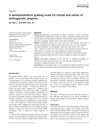The Convergence Between Diagnostic Methods in Women With Non-Scarring Hair Loss
October 2017
in “
Iranian Journal of Dermatology
”

TLDR Clinical exams are good for diagnosing some women's hair loss, but lab tests aren't always needed.
The study, involving 41 women with an average age of 28.1 years and a mean hair loss duration of 6.2 years, aimed to assess the correlation between different diagnostic methods for non-scarring hair loss. Androgenetic alopecia was the most commonly identified hair loss type. Clinical examination was found to have a high sensitivity of 94% but a low specificity of 25% in detecting this condition. Laboratory tests, including hormone levels and iron, did not show a significant correlation with the clinical diagnosis. The study concluded that clinical examination can be effective in diagnosing certain types of non-scarring hair loss in women, but histopathologic studies are crucial for a definitive diagnosis, and routine endocrinology and laboratory tests may not be necessary for all hair loss cases.


